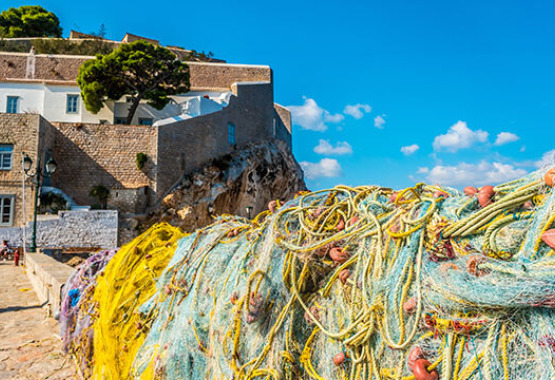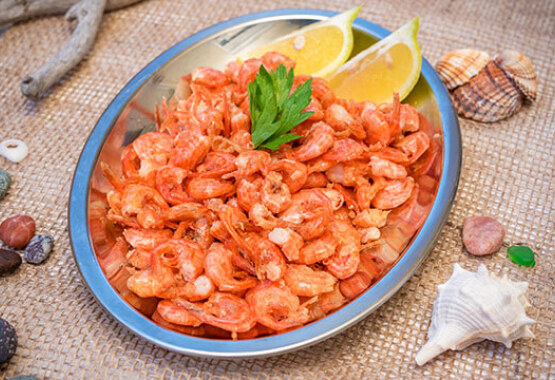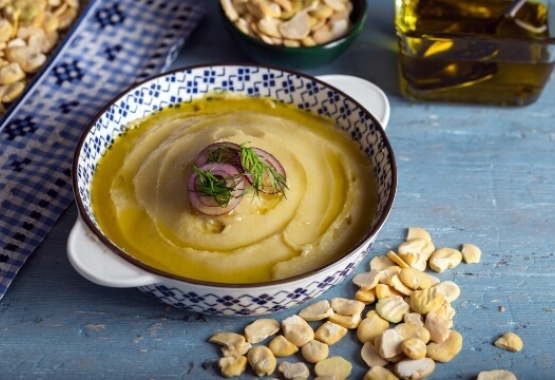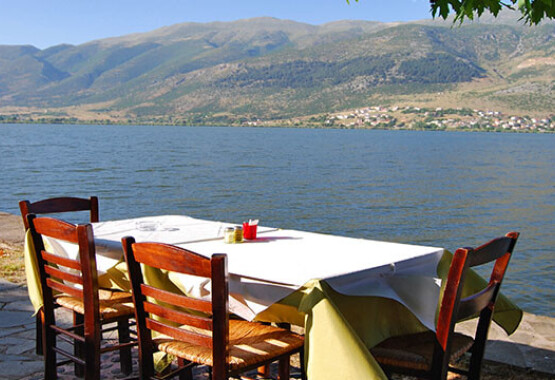
SKIATHOS
You will find many varieties of fish and seafood in the rocky bays and small islets. The area around Lalaria, and around the islets, at Tsougrias or Kastro are spots that are considered ideal for fishing. Laid out in crates against the boats, pelagic fish for soups and grilling, bottom feeders for frying, squid, crayfish, prawns, lobster, cockles and mussels shimmer in the early light.
They are cooked in a variety of ways: we can enjoy squid with “horta” and onions, crayfish with courgettes and tomato, lobster with “horta”. Seafood is accompanied with vegetables and “horta”, with legumes and different sauces, each one special thanks to the herbs added, most frequently fennel which grows abundantly on the island. Green olives can also be marinated with fennel. Wild “horta” is also very tasty and goes well with seafood.
And since there is “horta” in abundance, there is also “hortopita” made with traditional filo pastry, the so-called “kalapodia”. You can also taste the spiral shaped “tiropita” (cheese pie) over whose origin the two great authors Papadiamantis and Moraitidis argued. One said “Skiathos” and the other said “Skopelos”.
Papadiamantis with his special linguistic ability in his short story “Mavromantilou” (Black Scarf Rock) describes with great pride the garden vegetables: “(…) their atoms mingled ceaselessly in shapes that were varied, unchanging and fluid, in rearing and lifting swells; they seethed, struck, thundered, sounded, smacked, and crashed against their fellows’ [trans “Lia Dain Sherrard, the Boundless Garden, Vol I].
The “aspro” is a traditional dessert made with finely chopped almonds, sugar syrup and lemon. The secret is in the blending with the syrup. It needs to be well beaten until it turns white. Traditionally a homemade walnut or cherry liqueur is served at festivals on Skiathos.
The Women’s Association prepares these and other fruit and botanical liqueurs, such as the aromatic rose geranium, in the traditional manner by leaving them for 40 days in the sun. Sweets served at weddings include the famous “hamalia”, which is a mixture of walnuts and local pine honey, which is wrapped in filo pastry, fried and then dusted with icing sugar. Another classic choice is “kidonopasta” (quince paste). Your sweet tooth will be assuaged further by trying the local organic honey, which has achieved international recognition.
Wine tasting in the charming environs of the island, with high quality wine, in which the “roditis” and “malagouzia” grapes dominate, will complement your gastronomic experiences.
The cuisine of Skiathos
The gastronomic delights of the island always were and continue to be special.
In the past fishermen exchanged the treasures of the sea for the farmers’ vegetables and oil. This bartering created a fragnant cuisine based on seafood and “horta” (wild greens); fish stew (dentex, white grouper, dusky grouper ank monkfish), fava (puree of yellow split peas) with sardines, “tsoflia” (as the locals call crayfish and lobster) with courgettes and "horta" from the mountains. Chard, sow thistle, chervil, innumerable wild greens are married magically with seafood, highlighting the aromas of the place.You will find many varieties of fish and seafood in the rocky bays and small islets. The area around Lalaria, and around the islets, at Tsougrias or Kastro are spots that are considered ideal for fishing. Laid out in crates against the boats, pelagic fish for soups and grilling, bottom feeders for frying, squid, crayfish, prawns, lobster, cockles and mussels shimmer in the early light.
They are cooked in a variety of ways: we can enjoy squid with “horta” and onions, crayfish with courgettes and tomato, lobster with “horta”. Seafood is accompanied with vegetables and “horta”, with legumes and different sauces, each one special thanks to the herbs added, most frequently fennel which grows abundantly on the island. Green olives can also be marinated with fennel. Wild “horta” is also very tasty and goes well with seafood.
And since there is “horta” in abundance, there is also “hortopita” made with traditional filo pastry, the so-called “kalapodia”. You can also taste the spiral shaped “tiropita” (cheese pie) over whose origin the two great authors Papadiamantis and Moraitidis argued. One said “Skiathos” and the other said “Skopelos”.
Papadiamantis with his special linguistic ability in his short story “Mavromantilou” (Black Scarf Rock) describes with great pride the garden vegetables: “(…) their atoms mingled ceaselessly in shapes that were varied, unchanging and fluid, in rearing and lifting swells; they seethed, struck, thundered, sounded, smacked, and crashed against their fellows’ [trans “Lia Dain Sherrard, the Boundless Garden, Vol I].
The “aspro” is a traditional dessert made with finely chopped almonds, sugar syrup and lemon. The secret is in the blending with the syrup. It needs to be well beaten until it turns white. Traditionally a homemade walnut or cherry liqueur is served at festivals on Skiathos.
The Women’s Association prepares these and other fruit and botanical liqueurs, such as the aromatic rose geranium, in the traditional manner by leaving them for 40 days in the sun. Sweets served at weddings include the famous “hamalia”, which is a mixture of walnuts and local pine honey, which is wrapped in filo pastry, fried and then dusted with icing sugar. Another classic choice is “kidonopasta” (quince paste). Your sweet tooth will be assuaged further by trying the local organic honey, which has achieved international recognition.
Wine tasting in the charming environs of the island, with high quality wine, in which the “roditis” and “malagouzia” grapes dominate, will complement your gastronomic experiences.




